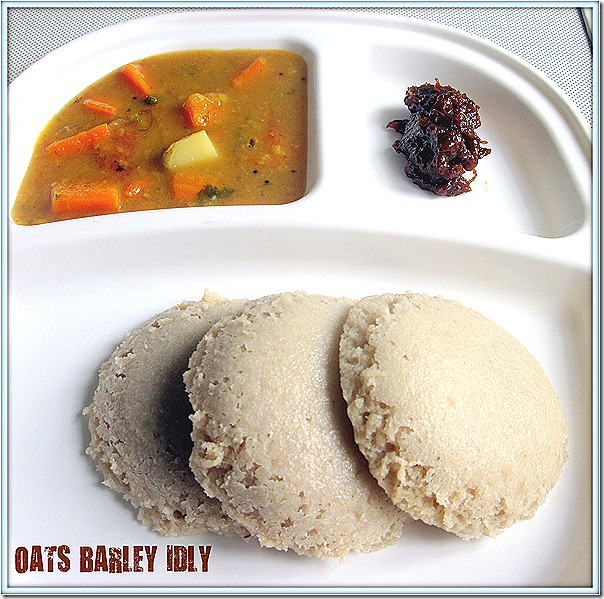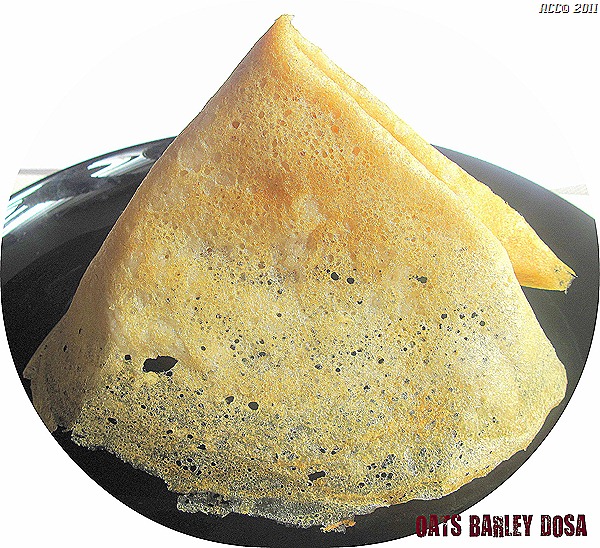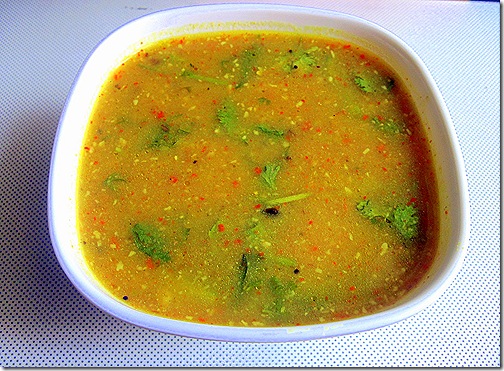domingo, 29 de abril de 2012
Waiter, there's goat cheese in my burrito!
jueves, 26 de abril de 2012
Momofuku's Ginger Scallion Noodles
sábado, 21 de abril de 2012
we made our own double down
viernes, 20 de abril de 2012
OATS BARLEY IDLY–FERMENTATION METHOD
I got an idea of making barley idly from here. I followed the same recipe. The idly was super soft and tasty. I was not able to find i added barely.Thanks Aruna.Nowadays i make this idly very often.I wanted to make some changes to the recipe by adding oats and tried sterday.My hubby was surprised & asked me whether i've added oats and barley because there was no change in taste or smell from the usual idly.Only the color of idly was changed.He was very happy to have this idly for breakfast and dinner.I made dosas too. It was crispy and yummy..
| INGREDIENTS
|
METHOD
Enjoy soft , healthy idlies with sambhar or chutney !! |
POINTS TO REMEMBER
|
KITCHEN CLINIC
| Barley: a nutritional powerhouse As cereal grains go, barley is a winner when it comes to good nutrition. This centuries-old grain is packed with fiber, contains important vitamins and minerals, is slim on fat, and, like all plant products, cholesterol-free. Here's a closer look: Fiber Cholesterol and fat Vitamins and minerals Antioxidants Phytochemicals HEALTH BENEFITS
Caution
Cooking Tips
Kinds of BarleyBarley nutrition today comes in all forms possible. The grain, the leaves and the extract of barley are all used as food sources. Here are some of the most widely used forms of barley nutrition:
As you can see, barley nutrition comes in all forms, so it is easier for us to take advantage of its nutritional benefits. |
martes, 17 de abril de 2012
UPPU SAARU / BITTERGOURD RASAM
I learnt this delicious kuzhambu /rasam from my MIL.Just like Kazhani kuzhambu , this is also an easy , unique recipe.I usually make pitlai with BG.But this is something different in taste and the procedure.Here comes the recipe with the picture..
INGREDIENTS :
- Bittergourd - 1 no (medium size)
- Tamarind - Small gooseberry size
- Salt & water - As needed
To roast & grind :
- Oil - 1 tsp
- Toor dal - 1.5 tsp
- Channa dal- 1 tsp
- Urad dal - 1 tsp
- Red chilly - 4 -5 nos
- Grated Coconut - 1 tbsp
To temper :
- Mustard seeds - 1 tsp
- Urad dal - 1/2 tsp
- Curry leaves - few
METHOD :
- Slice cut Bittergourd with 1 inch thickness.
- In a pressure cooker , take the bittergourd slices and cook till 1 whistle.
- Take a tsp of oil in a kadai and roast the ingredients given above. Powder it coarsely and set aside.
- In the kadai , heat oil and temper the items given under 'to temper'. Now add the tamarind extract , salt , hing and curry leaves.
- Add the cooked bittergourd pieces and allow it to boil for sometime.
- Now mix the coarsely ground powder and boil for 5 mins.
- The mixture should be watery in consistency.
- Finally garnish with coriander leaves.
Serve hot with plain rice & papad.
KITCHEN CLINIC :
| BITTER GOURD : The bitter melon (also known as bitter gourd) looks like a cucumber but with ugly gourd-like bumps all over it. As the name implies, this vegetable is a melon that is bitter. There are two varieties of this vegetable: One grows to about 20 cm long, is oblong and pale green in color. The other is the smaller variety, less than 10 cm long, oval and has a darker green color. Both varieties have seeds that are white when unripe and that turn red when they are ripe. The vegetable-fruit turn reddish-orange when ripe and becomes even more bitter. Bitter gourd thrives in hot and humid climates, so are commonly found in Asian countries and South America. Westerners may not be so used to bitter melons, so may find them more difficult to consume. But if you can generally take bitter taste, you may be able to take this too. Try it, at least for all its healthful virtues! Nutritional Benefits Bitter gourds are very low in calories but dense with precious nutrients. It is an excellent source of vitamins B1, B2, and B3, C, magnesium, folic acid, zinc, phosphorus, manganese, and has high dietary fiber. It is rich in iron, contains twice the beta-carotene of broccoli, twice the calcium of spinach, and twice the potassium of a banana. Bitter melon contains a unique phyto-constituent that has been confirmed to have a hypoglycemic effect called charantin. There is also another insulin-like compound known as polypeptide P which have been suggested as insulin replacement in some diabetic patients. Health Benefits Few other fruits/vegetables offer medicinal properties for these ailments like bitter melon does. Blood disorders: Bitter gourd juice is highly beneficial for treating blood disorders like blood boils and itching due to toxemia. Mix 2 ounces of fresh bitter gourd juice with some lime juice. Sip it slowly on an empty stomach daily for between four and six months and see improvement in your condition. Cholera: In early stages of cholera, take two teaspoonfuls juice of bitter gourd leaves, mix with two teaspoonfuls white onion juice and one teaspoonful lime juice. Sip this concoction daily till you get well. Diabetes mellitus: Bitter melon contains a hypoglycemic compound (a plant insulin) that is highly beneficial in lowering sugar levels in blood and urine. Bitter melon juice has been shown to significantly improve glucose tolerance without increasing blood insulin levels. Energy: Regular consumption of bitter gourd juice has been proven to improve energy and stamina level. Even sleeping patterns have been shown to be improved/stabilized. Eye problems: The high beta-carotene and other properties in bitter gourd makes it one of the finest vegetable-fruit that help alleviate eye problems and improving eyesight. Hangover: Bitter melon juice may be beneficial in the treatment of a hangover for its alcohol intoxication properties. It also help cleanse and repair and nourish liver problems due to alcohol consumption. Immune booster: This bitter juice can also help to build your immune system and increase your body's resistance against infection. Piles: Mix three teaspoonfuls of juice from bitter melon leaves with a glassful of buttermilk. Take this every morning on empty stomach for about a month and see an improvement to your condition. To hasten the healing, use the paste of the roots of bitter melon plant and apply over the piles. Psoriasis: Regular consumption of this bitter juice has also been known to improve psoriasis condition and other fungal infections like ring-worm and athletes feet. Respiratory disorders: Take two ounces of fresh bitter melon juice and mix with a cup of honey diluted in water. Drink daily to improve asthma, bronchitis and pharyngitis. Toxemia: Bitter gourd contains beneficial properties that cleanses the blood from toxins. Sip two teaspoonfuls of the juice daily to help cleanse the liver. Also helpful in ridding jaundice for the same reasons. |
sábado, 14 de abril de 2012
http://feedproxy.google.com/~r/SpanishRecipesinpictures/~3/_Zv-2z7SCaA/empanadillas-de-atun-tuna-patties.html
Get the rest in my blog! See you there!
martes, 10 de abril de 2012
lunes, 9 de abril de 2012
How to Eat for $7 or Less a Day

Welcome new readers! If you found my blog in the US News & World Report story about living on a budget on Yahoo! Finance and are looking for budget shopping and cooking ideas, please check out my Hunger Challenge posts. You'll find recipes, tips and more.
Thanks!
Amy




